Duff Surname Ancestry ResultsOur indexes 1000-1999 include entries for the spelling 'duff'. In the period you have requested, we have the following 690 records (displaying 511 to 520): Single Surname Subscription | | | Buying all 690 results of this search individually would cost £3,796.00. But you can have free access to all 690 records for a year, to view, to save and print, for £100. Save £3,696.00. More... |
These sample scans are from the original record. You will get scans of the full pages or articles where the surname you searched for has been found. Your web browser may prevent the sample windows from opening; in this case please change your browser settings to allow pop-up windows from this site.  Outstanding soldiers of Princess Louise's (Argyll and Sutherland Highlanders)
(1881-1901) Outstanding soldiers of Princess Louise's (Argyll and Sutherland Highlanders)
(1881-1901)
Each year the best soldiers of the regiment were chosen for long service and good conduct medals. This register gives rank, name, regimental number, and date of recommendation. (The sample scan is from the East Surrey regiment). The register is essentially a register of recommendations, annotated with details of the issue of the medals. Where no gratuity accompanied the medal, the entry is marked 'W. G.' (without gratuity); where, for one reason or another, the medal was not issued, the entry is marked 'N. S.' (not sanctioned) and struck through. The Argyll and Sutherland Highlanders were based at Regimental District No. 91, Stirling. The 1st battalion embarked for Natal 19 February 1879, adding "South Africa, 1879" to the regimental honours. In 1885 they were transferred to Ceylon, and in 1888 to Hong Kong, returning to Scotland 23 March 1892. In 1894 the 1st battalion was moved to England; in 1895 it was at Aldershot; in 1898 it returned to Scotland; in 1899 it was sent to Ireland, and then transferred to South Africa, where it gained the honours "South Africa, 1899-1902", "Modder River" and "Paardeberg". The 2nd battalion returned from Gibraltar to England in 1881, was moved to Scotland in 1882, and back to England in 1884, and in 1885 was at Portsmouth. The 2nd battalion was sent to Ireland in 1886, returned to England in 1890, and 26 November 1891 embarked for India; by 1895 it was based at Meean Meer. The 2nd battalion took part in the North-West Frontier campaign of 1897 to 1898.DUFF. Cost: £8.00.  | Sample scan, click to enlarge
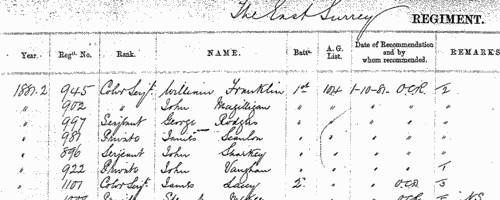
|  Outstanding soldiers of the Seaforth Highlanders (Ross-shire Buffs, The Duke of Albany's)
(1881-1901) Outstanding soldiers of the Seaforth Highlanders (Ross-shire Buffs, The Duke of Albany's)
(1881-1901)
Each year the best soldiers of the regiment were chosen for long service and good conduct medals. This register gives rank, name, regimental number, and date of recommendation. (The sample scan is from the East Surrey regiment). The register is essentially a register of recommendations, annotated with details of the issue of the medals. Where no gratuity accompanied the medal, the entry is marked 'W. G.' (without gratuity); where, for one reason or another, the medal was not issued, the entry is marked 'N. S.' (not sanctioned) and struck through. The regiment was based on the 72nd Regimental District - Fort George. The 1st battalion moved from India to Aden 25 February 1882, and arrived in Egypt 2 August 1882, taking part in the Egyptian war, and adding "Egypt, 1882" and "Tel-el-Kebir" to the regimental honours. It returned to England 15 October 1882, and was stationed at Parkhurst. In 1886 it was transferred to Scotland; in 1889 to Ireland (based at Tipperary); in 1895 back to England, and in 1897 was sent off to Malta to take part in the occupation of Crete. From there it was transferred to Egypt for the Soudan campaign of 1898 ("Khartoum" and "Atbara"). The 2nd battalion embarked for Bombay in 1879, and by 1885 was based at Lucknow; and by 1895 at Ferozepore. It took part in the Hazara Relief Force of 1891 and the Chitral Relief Force of 1895 ("Chitral"). Having returned to England in 1897, the battalion was sent to South Africa in 1899, where it gained the honours "South Africa, 1899-1902" and "Paardeberg".DUFF. Cost: £8.00.  | Sample scan, click to enlarge
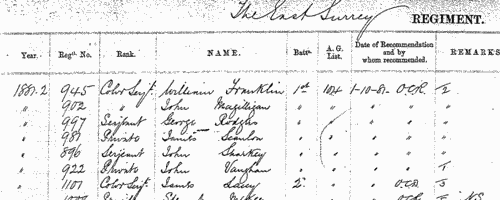
|  Outstanding soldiers of the York and Lancaster Regiment
(1881-1901) Outstanding soldiers of the York and Lancaster Regiment
(1881-1901)
Each year the best soldiers of the regiment were chosen for long service and good conduct medals. This register gives rank, name, regimental number, and date of recommendation. (The sample scan is from the East Surrey regiment). The register is essentially a register of recommendations, annotated with details of the issue of the medals. Where no gratuity accompanied the medal, the entry is marked 'W. G.' (without gratuity); where, for one reason or another, the medal was not issued, the entry is marked 'N. S.' (not sanctioned) and struck through. The regiment was based on the 65th Regimental District - Pontefract. The 1st battalion returned from Egypt 21 April 1884, the regiment having gained the honours "Egypt, 1882" and "Tel-el-Kebir". In 1885 it was based at Dover. In 1889 the battalion was sent to Ireland; it was at Cork in 1895; returning to England in that year. In 1899 the battalion went out to South Africa, adding "South Africa, 1900-1902" and "Relief of Ladysmith" to the regimental honours. The 2nd battalion returned from Egypt in 1883, but in October of that year embarked for Bermuda; in 1886 was moved to Halifax, Nova Scotia; in 1888 to the West Indies; in 1891 to South Africa; in 1897 to Mauritius; and on to India.DUFF. Cost: £8.00.  | Sample scan, click to enlarge
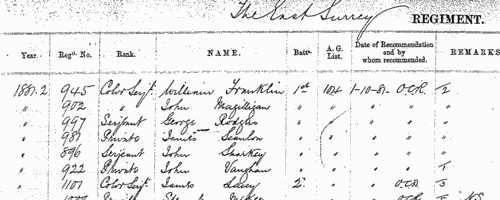
| Boys entering Trinity College, Glenalmond
(1901)
Trinity College, Glenalmond, Perthshire, was originally founded as a college at which young men might be trained for the ministry of the Scottish Episcopal Church, and the sons of the laity might be educated and brought up in the faith and tradition of the Church. In 1876 the Theological College was transferred to Edinburgh, Glenalmond remaining as a boys' school. This second edition of the school register, edited by G. St Quintin, was published in 1955, incorporating the text of the first edition prepared by E. W. Neish. The scholars are listed by term of entering the school, and then alphabetically by surname; the details then given are full christian names, date of birth; name of father; any distinctions within the school; and then a career synopsis, with date and place of death where known. DUFF. Cost: £6.00.  | Sample scan, click to enlarge
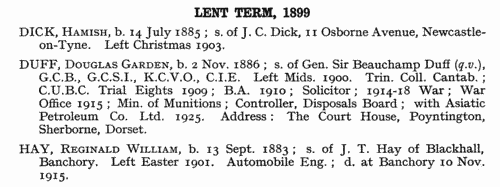
| Unclaimed Naval Prize Money
(1855-1902)
Various prize moneys were awarded to officers and men who served on board her Majesty's ships. For one reason or another a substantial number of these prizes, from as little as a shilling or two to as much as many pounds, remained undistributed by 1902, when this comprehensive list of the unclaimed moneys was printed: it lists unclaimed shares of prize money, slave and pirate bounties, salvage awards, parliamentary grants, gratuities and other moneys distributed by the Admiralty 1855 to 1902, but which omits moneys for service on the China Station during the war of 1856 to 1880, and special gratuities for service in Egypt (1882), Soudan (1884) and Soudan and Nile Expedition (1884-1885), for which there are separate indexes. In each case the sailor's name is given first (surname, then christian name or initials); rank or rating; ship in which serving at time of capture or award; and the amount due.DUFF. Cost: £6.00.  | Sample scan, click to enlarge

|  London Metropolitan Police
(1892-1902) London Metropolitan Police
(1892-1902)
The London Metropolitan Police Register of Joiners (MEPO 4/336) lists policemen joining the force 1 January 1892 to 23 June 1902 (warrant numbers 77319 to 88811). The register is alphabetical, in so far as the recruits are listed chronologically grouped under first letter of surname. It gives Date of Appointment, Name, Number of Warrant, Cause of Removal from Force (resigned, dismissed, promoted or died), and Date of Removal. A final column of 'Remarks' is largely blank, but occasionally gives an alias or a cross-reference to another warrant number.DUFF. Cost: £8.00.  | Sample scan, click to enlarge

|  British artillerymen fighting in South Africa
(1899-1902) British artillerymen fighting in South Africa
(1899-1902)
The Queen Victoria's South Africa Medal was awarded (after her death, in the event) to all who had served honourably in the various campaigns in the Boer War. Returns were made from each unit, and consolidated into nominal roll, of which this is the one for the Royal Artillery. Confusingly, the ledgers used had originally been printed for a register of men transferred (or re-transferred after mobilization) to 1st Class Army Reserve. All the original column headings were therefore struck through, and the roll was prepared with this information: Date of Issue; Regimental Number; Rank; Name; Unit; Medal (a 1 indicating that a medal was awarded); [number of] Clasps; the reference to the source in the original returns, usually starting with AG for papers in the hands of the Adjutant-General, and 68/Art/ for the Royal Artillery records. The final column, normally left blank, was occasionally used for explanatory remarks.DUFF. Cost: £8.00.  | Sample scan, click to enlarge

| Boys entering Fettes College, Edinburgh
(1902)
Fettes College, Edinburgh, was opened in 1870 under the terms of a trust 'for maintenance, education, and outfit of young people whose parents have either died without leaving sufficient funds for that purpose, or who, from innocent misfortune during their own lives, are unable to give suitable education to their children'. In 1923 this edition of the Fettes College Register was published; in it the compilers sought to set out for each boy who had attended the college a brief synopsis of what was known about his time at the school, his subsequent career, and date and place of death, or address as of 1923. Of course, for most of the boys entering the school in the early 20th century, their career was still ahead of them. After each name there is a letter in brackets indicating the house to which the pupil belonged - (C.) Carrington House; (G.) Glencorse House; (K.) Kimmerghame House; (M.) Moredun House; (S.) Schoolhouse. An asterisk indicates that the boy was a foundationer, i. e. supported by the foundation; a dagger that he was a foundation scholar. VIA. indicates Upper Form; Mods. Modern School; Army Cl., Army Class; S. P., School Prefect; xx. First Rugby Football Twenty; xv. First Rugby Football Fifteen; xx. cap. Caps occasionally given to the five (or fewer) next to the First Fifteen after 1875; xi. First Cricket Eleven; viii. Gymnastic Eight; Trs. Prizes and Exhib., Trustees' Prizes and Exhibitions; Govs. Prizes and Exhib., Governors' Prizes and Exhibitions; Schol., scholarship; M., married. Month and year of birth is given in square brackets.DUFF. Cost: £4.00.  | Sample scan, click to enlarge
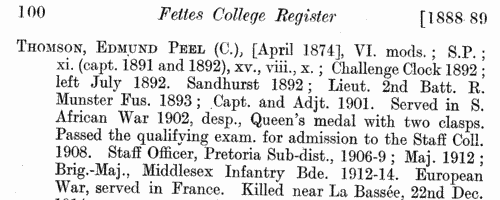
| Associate Members of the Institution of Civil Engineers
(1904)
The Institution of Civil Engineers was established 2 January 1818, and incorporated by royal charter 3 June 1828. The annual report lists the names and addresses (throughout the world) of the four classes of member - members (M. Inst. C. E.), associate members (Assoc. M. Inst. C. E.), associates (Assoc. Inst. C. E.), students (Stud. Inst. C. E.) - with the dates of admission. This is the index to the Associate Members. The symbols at the left of each page are * for Former Students, + for contributors of papers published in the Minutes of Proceedings, or of an Engineering Conference Note; F for a deliverer of a James Forrest Lecture; L for a deliverer of one of the Special Series of Lectures; and various letters for recipients of certain medals and prizes - B, Bayliss Prize; C, Crampton Prize; f, James Forrest Medal; H, Howard Quinquennial Prize; J, Joule Medal; M, Miller Scholarship; m, Miller Prize; italic m, Manby Premium; S, George Stephenson Medal or Prize; T, Telford Premium; t, Telford Premium; italic t, Trevithick Premium; and W, Watt Medal. Those elected prior to 2 December 1878 had been transferred into this class by the Council.DUFF. Cost: £6.00.  | Sample scan, click to enlarge
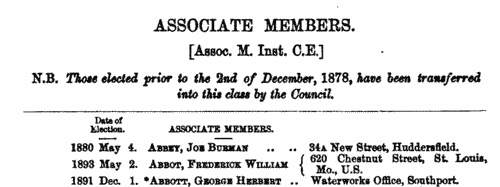
| Boys entering Trinity College, Glenalmond
(1904)
Trinity College, Glenalmond, Perthshire, was originally founded as a college at which young men might be trained for the ministry of the Scottish Episcopal Church, and the sons of the laity might be educated and brought up in the faith and tradition of the Church. In 1876 the Theological College was transferred to Edinburgh, Glenalmond remaining as a boys' school. This second edition of the school register, edited by G. St Quintin, was published in 1955, incorporating the text of the first edition prepared by E. W. Neish. The scholars are listed by term of entering the school, and then alphabetically by surname; the details then given are full christian names, date of birth; name of father; any distinctions within the school; and then a career synopsis, with date and place of death where known. DUFF. Cost: £6.00.  | Sample scan, click to enlarge
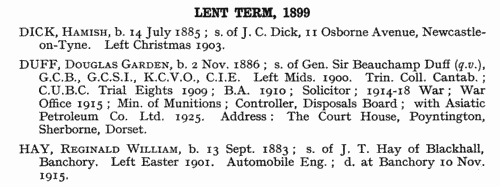
|
Research your ancestry, family history, genealogy and one-name study by direct access to original records and archives indexed by surname.
|













